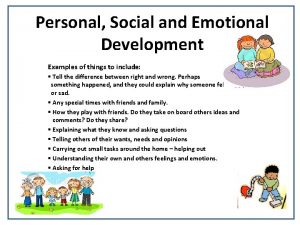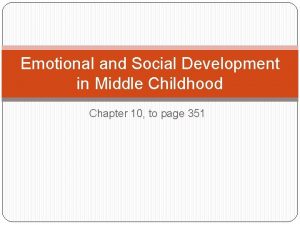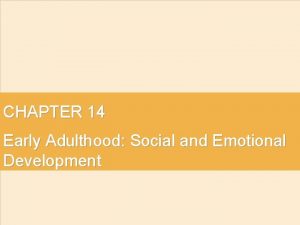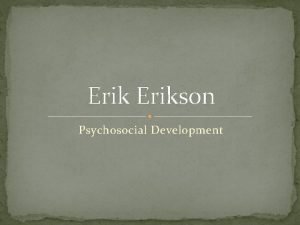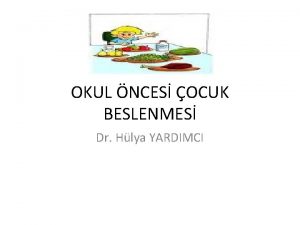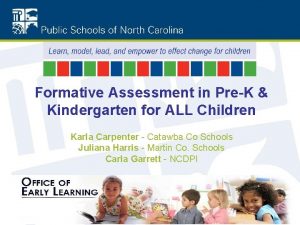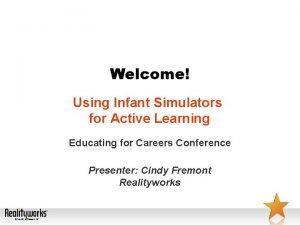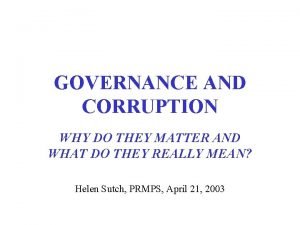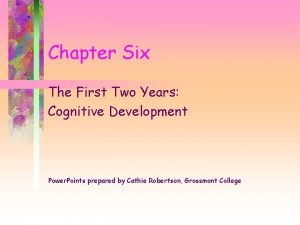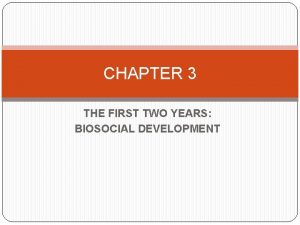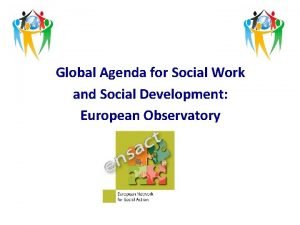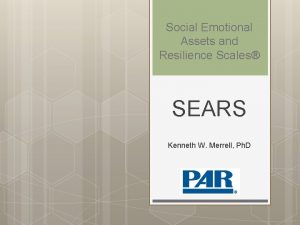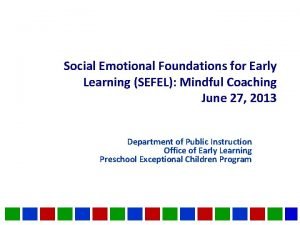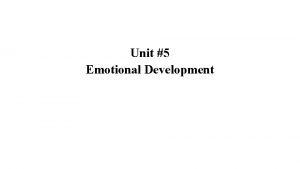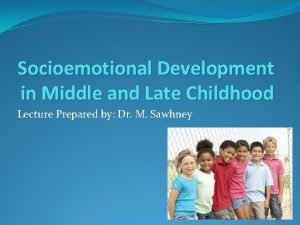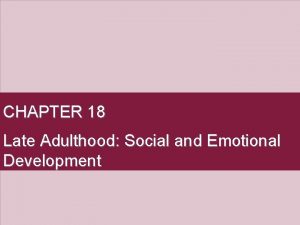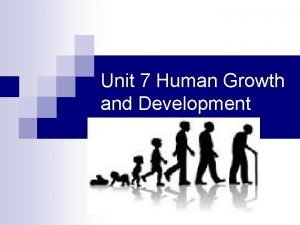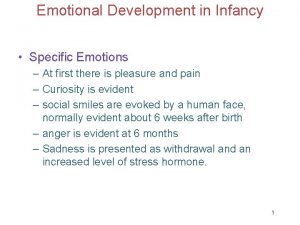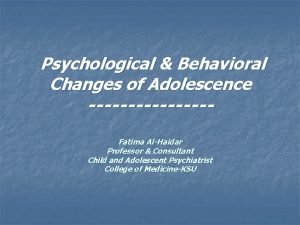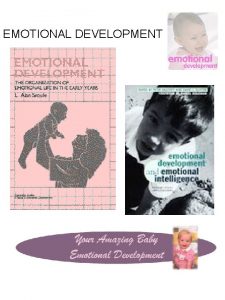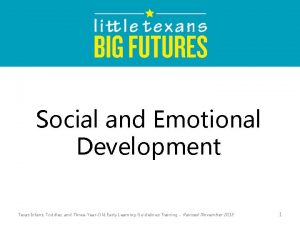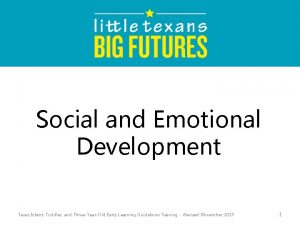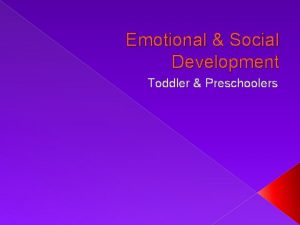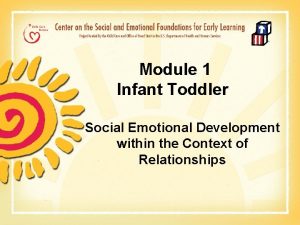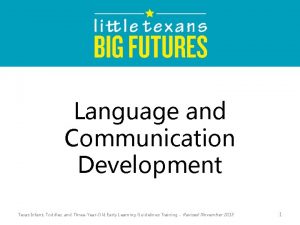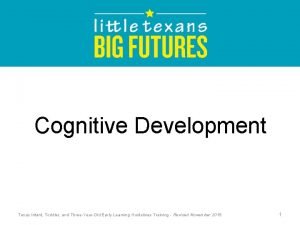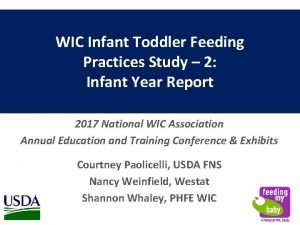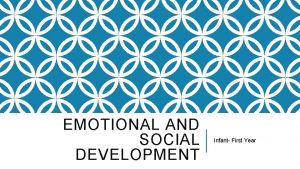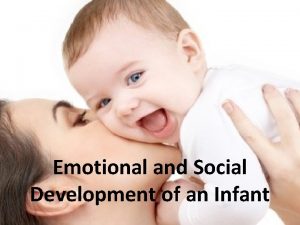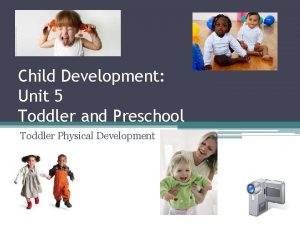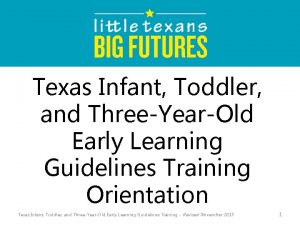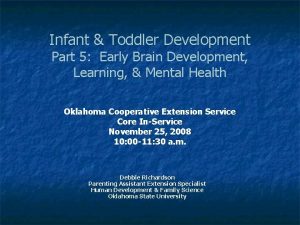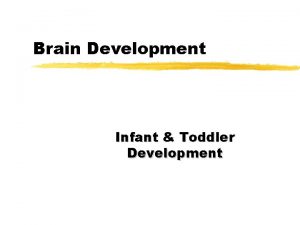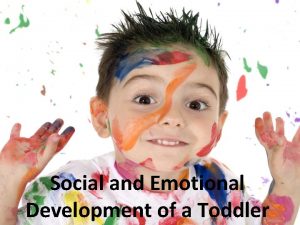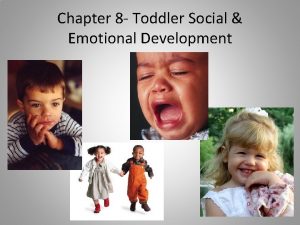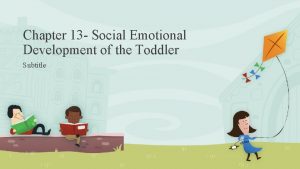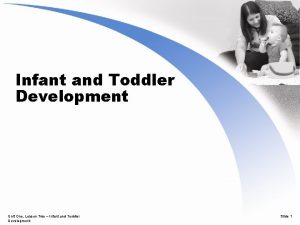Social and Emotional Development Texas Infant Toddler and










































- Slides: 42

Social and Emotional Development Texas Infant, Toddler, and Three-Year-Old Early Learning Guidelines Training - Revised November 2015 1

Agenda • Responsive Caregiving • Attachment • Self-Awareness • Emotional Development and Self Regulation • Relationships with Others • Promoting Positive Interactions • Inclusion Texas Infant, Toddler, and Three-Year-Old Early Learning Guidelines Training - Revised November 2015 2

Objectives Describe secure attachment and explain the caregiver’s role Create a strategy for responsive caregiving in a stressful situation List four to five classroom materials that can promote self-awareness Compile best practices for peaceful and appropriate transitions Develop an inclusion strategy for a child with special needs Texas Infant, Toddler, and Three-Year-Old Early Learning Guidelines Training - Revised November 2015 3

Attachment Take out your Participant Guide. You will see the attachment chart. Please use this chart to take notes. Texas Infant, Toddler, and Three-Year-Old Early Learning Guidelines Training - Revised November 2015 4

Attachment • Responds appropriately, promptly, and consistently to needs • Little or no response to distressed child • Discourages crying and encourages independence • Inconsistent between appropriate and neglectful responses • Generally responds only after increased attachment behavior from the infant • Frightened or frightening behavior, abusive or neglectful • Uses caregiver as secure base in exploration • Distressed when caregiver leaves, happy when they return • Seeks caregiver in stressful situations • Little affective sharing in play • Little or no distress on departure • Child may be rebellious and has a lower self-image and self • esteem Preoccupied w/ caregiver's availability • Seeks contact but resists angrily when it is achieved • Not easily calmed by stranger • Always anxious because caregiver's availability is never • consistent. Displays no attachment behaviors towards caregiver Texas Infant, Toddler, and Three-Year-Old Early Learning Guidelines Training - Revised November 2015 5

Attachment Style – Secure • Caregiver Behavior – Responds appropriately, promptly, and consistently to needs • Child Behavior – Distressed when caregiver leaves, happy when they return. Texas Infant, Toddler, and Three-Year-Old Early Learning Guidelines Training - Revised November 2015 6

Attachment Style – Avoidant • Caregiver Behavior – Little or no response to distressed child. Discourages crying and encourages independence. • Child Behavior – Little or no distress on departure. Child may have lower selfimage or self-esteem. Texas Infant, Toddler, and Three-Year-Old Early Learning Guidelines Training - Revised November 2015 7

Attachment Style – Ambivalent/Resistant • Caregiver Behavior – Inconsistent between appropriate and neglectful responses • Generally responds only after increased attachment behavior from the infant • Child Behavior – Always anxious because caregiver’s availability is never consistent Texas Infant, Toddler, and Three-Year-Old Early Learning Guidelines Training - Revised November 2015 8

Attachment Style – Disorganized • Caregiver Behavior – Frightened or frightening behavior, abusive or neglectful. • Child Behavior – Displays no attachment behaviors towards caregiver. Texas Infant, Toddler, and Three-Year-Old Early Learning Guidelines Training - Revised November 2015 9

Responsive Caregiving Observe the child’s needs Respond appropriate ly Child receives the response and needs are met Texas Infant, Toddler, and Three-Year-Old Early Learning Guidelines Training - Revised November 2015 10

Responsive Caregiving • Take out your participant guide and take a few minutes to fill out the question at the top of page 2. • We will ask for a few volunteers to share thoughts. Texas Infant, Toddler, and Three-Year-Old Early Learning Guidelines Training - Revised November 2015 11

Trust and Emotional Security The Indicators are: • Establishes secure relationships with primary caregiver • Differentiates between familiar and unfamiliar adults • Shows emotional connections and attachment to others while beginning to show Texas Infant, Toddler, and Three-Year-Old Early Learning Guidelines Training - Revised November 2015 independence 12

Responsive Caregiving 0 -8 Months • Hold, cuddle, and laugh with infants • Hold infants during bottle feeding time; talk to them in a calm and soothing tone • Notice, understand, and follow the signals of infants, such as cries of hunger or pain, turning away when full, or when ready to stop interacting • Display courteousness, warmth, and sensitivity when interacting with Texas Infant, Toddler, and Three-Year-Old Early Learning Guidelines Training - Revised November 2015 13 adults and children

Responsive Caregiving 8 -18 Months • Notice and be responsive to words, gestures, laughs, and cries • Stay close and visible while infants explore • Reassure them that you will return, explaining where you are going and when you will be back • Introduce them to new people and allow them time to become comfortable. 18 -36 Months • Provide encouragement for trying activities and playing with new people Texas Infant, Toddler, and Three-Year-Old Early Learning Guidelines Training - Revised November 2015 14

Responsive Caregiving 36 -48 Months • Connect with three-year-olds on a daily basis, such as naptime or arrival • Respond with affection and care when approached by an upset or hurt three-year olds • Encourage independence and participation in new situations (“Go ahead, you can do it!”) Texas Infant, Toddler, and Three-Year-Old Early Learning Guidelines Training - Revised November 2015 15

Responsive Caregiving Activity 1 • Responsive caregiving is most critical in moments of high stress and emotion. • Read the Responsive Caregiving Scenario on page 2 of your participant guide. Work together with your small group to create a responsive caregiving strategy for the scenario. Texas Infant, Toddler, and Three-Year-Old Early Learning Guidelines Training - Revised November 2015 16

Responsive Caregiving Activity 1 Continue/finish changing diaper; acknowledge parent, “Hi Ms. __, I hear and understand what you are saying. Can we schedule a time to have a conversation about your concerns? Please write down a time that would work best for you on the Parent Check-in sheet”. Acknowledge Rico’s cries and say, “Good afternoon Rico, I am on my way over there” and as you pass Julie, lovingly pat her and say, “You’re strong Julie! You’re pulling up on that shelf!” Texas Infant, Toddler, and Three-Year-Old Early Learning Guidelines Training - Revised November 2015 17

Self-Awareness Erikson’s Stages of Psychosocial Development Birth-12 months Trust vs. Mistrust 1 -3 years Doubt Autonomy vs. Shame and A theory of development based on the mastery of one stage in order to successfully progress to the next. Texas Infant, Toddler, and Three-Year-Old Early Learning Guidelines Training - Revised November 2015 18

Self-Awareness Birth – 12 Months Trust vs. Mistrust An infant needs maximum comfort with minimal uncertainty. A secure attachment to a responsive caregiver meets this need. Texas Infant, Toddler, and Three-Year-Old Early Learning Guidelines Training - Revised November 2015 19

Self-Awareness 1 – 3 years Autonomy vs Shame and Doubt A toddler works to master the physical environment while maintaining self-esteem. They are learning to balance hanging on and letting go in order to achieve autonomy. Texas Infant, Toddler, and Three-Year-Old Early Learning Guidelines Training - Revised November 2015 20

Self-Awareness • A clear and positive Sense of Self and identity • Self-Recognition of the baby in the mirror • Identifying the Categorical Self in social contexts based on age, sex and other visible characteristics • The Looking-Glass Self is understanding self based on the responses of others Texas Infant, Toddler, and Three-Year-Old Early Learning Guidelines Training - Revised November 2015 21

Self-Awareness The Indicators are: • Expresses needs and wants through facial expressions, sounds, or gestures • Develops awareness of self as separate from others • Shows confidence in increasing abilities • Shows awareness of relationship to family/ community/ cultural group Texas Infant, Toddler, and Three-Year-Old Early Learning Guidelines Training - Revised November 2015 22

Promoting Self-Awareness Activity 2 • Turn in your participant guide to page 3 and list materials that would promote self-awareness for each age group. • Take a few minutes to complete this and we will ask for volunteers to share. Texas Infant, Toddler, and Three-Year-Old Early Learning Guidelines Training - Revised November 2015 23

Promoting Self-Awareness Activity 2 Post pictures of children and their families Create personalized books Mirrors Label child’s cubby with name and picture Mirrors Post pictures showing child’s culture or home Feelinglanguage chart Books on feelings Mirrors Photos Books on different cultures Texas Infant, Toddler, and Three-Year-Old Early Learning Guidelines Training - Revised November 2015 24

Early Emotional Development At birth, infants can express contentment, distress, and interest. Within 6 months emotions begin to evolve from those. Distress Birth Sadness Anger Fear 3 Months 4 Months 5 Months Texas Infant, Toddler, and Three-Year-Old Early Learning Guidelines Training - Revised November 2015 Guilt and Shame 24 Months 25

Self-Regulation The Indicators are: • Begins to manage own behavior and demonstrates increasing control of emotion • Shows ability to cope with stress • Develops understanding of simple routines, rules or limitations Texas Infant, Toddler, and Three-Year-Old Early Learning Guidelines Training - Revised November 2015 26

Self-Regulation Caregivers can support self-regulation by: • Having realistic expectations of behavior • Not identifying a child by a negative behavior • Point out strengths and positive qualities • Balance the routine and the room arrangement with high-energy and peaceful activities and spaces • Use emotion words to help describe feelings • Be respectful of physical needs Texas Infant, Toddler, and Three-Year-Old Early Learning Guidelines Training - Revised November 2015 27

Relationships with Others The Indicators are: • Shows interest in and awareness of others • Responds to and interacts with others • Begins to recognize and respond to the feelings and emotions of others and begins to show concern Texas Infant, Toddler, and Three-Year-Old Early Learning Guidelines Training - Revised November 2015 28

Positive Interactions • Turn in your Participant Guide to page 3. Please use this section to take notes on the learning environment, routines/transitions and interactions. Texas Infant, Toddler, and Three-Year-Old Early Learning Guidelines Training - Revised November 2015 29

Positive Interactions Learning Environment • Create an atmosphere of trust and cooperation • Room arrangement provides clues for behavior • Engaging and interesting materials keep children busy with play and learning • Organization promotes self-help skills and cooperation Texas Infant, Toddler, and Three-Year-Old Early Learning Guidelines Training - Revised November 2015 30

Caregiver Responses Routines • Consistent from day to day • Provide a logical and predictable order of events • Appropriately flexible for the needs of the children Transitions • Use consistent signals for transition • Create logical transitions during natural breaks in activity • Eliminate all waiting time Texas Infant, Toddler, and Three-Year-Old Early Learning Guidelines Training - Revised November 2015 31

Caregiver Responses Activity 3 • Turn in your participant guide to page 4. • What best practices for transitions can you share with the group? Texas Infant, Toddler, and Three-Year-Old Early Learning Guidelines Training - Revised November 2015 32

Caregiver Responses Activity 3 • Share a few of your ideas for transitions. • Songs, rhymes, & bell-chimes • Prepare children with reminders of what is coming next • Provide prepared activities for children upon arrival • Being sensitive to children during transitions • Encourage parents to share information either verbally or by completing a brief questionnaire for children that are transitioning to another age group/teacher. Texas Infant, Toddler, and Three-Year-Old Early Learning Guidelines Training - Revised November 2015 33

Positive Interactions: • Build a relationship with the child • Provide valid choices • Redirect to a specific activity • Avoid power struggles Texas Infant, Toddler, and Three-Year-Old Early Learning Guidelines Training - Revised November 2015 34

Inclusion Aggression ADH D Social-communication deficits Autism Spectrum Disorders Social Anxiety Restricted interests and repetitive behaviors Expressive/receptive language disorders Intellectual disabilities Texas Infant, Toddler, and Three-Year-Old Early Learning Guidelines Training - Revised November 2015 35

Inclusion Strategies • Modify environment Snack Read Home • Adjust expectations • Provide visual supports – Project cards – Picture schedules • Communication • Provide appropriate choices • Create a reward system Texas Infant, Toddler, and Three-Year-Old Early Learning Guidelines Training - Revised November 2015 36

Inclusion Activity 4 • Turn to page 5 in your Participant Guide. • In small groups, read through the scenario and create 2 -3 inclusion strategies that might be appropriate for this child, then we will share a few. Texas Infant, Toddler, and Three-Year-Old Early Learning Guidelines Training - Revised November 2015 37

Inclusion Scenario Activity 4 Encourage conversations among the children and Lakisha during meals. This helps Lakisha develop social skills. Plan activities in the classroom that Lakisha can easily participate in with the other children, such as building blocks, painting and coloring. Allow additional time for completion of activities. Modify the environment by creating a comfortable and adequate space for Lakisha’s adapted chair. Texas Infant, Toddler, and Three-Year-Old Early Learning Guidelines Training - Revised November 2015 38

Social/Emotional Word Find Activity • Take out your Word Find Activity Handout • Work in groups of 2 -3 at your table to find the hidden words Texas Infant, Toddler, and Three-Year-Old Early Learning Guidelines Training - Revised November 2015 39

Social/Emotional Word Find Activity Texas Infant, Toddler, and Three-Year-Old Early Learning Guidelines Training - Revised November 2015 40

Conclusion • The earliest caregivers set the course for social/emotional development and contribute significantly to the child’s success or struggle. • Responsive caregiving, high-quality learning environments rich in language, and interactions with peers will scaffold a child through the stages of social and emotional development. Texas Infant, Toddler, and Three-Year-Old Early Learning Guidelines Training - Revised November 2015 41

Conclusion • Action Plan – Based on what I’ve learned today, what changes will I make next? • Q&A Texas Infant, Toddler, and Three-Year-Old Early Learning Guidelines Training - Revised November 2015 42
 Brigance test for 4-year-old
Brigance test for 4-year-old Drdp preschool essential view
Drdp preschool essential view Infant/toddler sensory profile score sheet
Infant/toddler sensory profile score sheet Personal social examples
Personal social examples Emotional development in middle childhood
Emotional development in middle childhood Social and emotional development in middle adulthood
Social and emotional development in middle adulthood Socioemotional development in early adulthood
Socioemotional development in early adulthood Emotional development in late adulthood
Emotional development in late adulthood Generativity stage
Generativity stage Banajee list of toddler vocabulary
Banajee list of toddler vocabulary Peylonephritis
Peylonephritis Toddler dönemi nedir
Toddler dönemi nedir Toddler fracture
Toddler fracture Toddler fever 102
Toddler fever 102 Toddler observation examples
Toddler observation examples Infant personality development
Infant personality development Cone of experience
Cone of experience Corruption
Corruption Social impulses foster infant language
Social impulses foster infant language Social impulses foster infant language
Social impulses foster infant language Global agenda for social work and social development
Global agenda for social work and social development Late childhood
Late childhood Emotional development is often stormy and in conflict
Emotional development is often stormy and in conflict What is visitor pre registration in picme
What is visitor pre registration in picme Sears rating scale
Sears rating scale Social and emotional wellbeing framework
Social and emotional wellbeing framework Social and emotional foundations for early learning
Social and emotional foundations for early learning What is the definition of emotional development
What is the definition of emotional development Middle & late childhood
Middle & late childhood Emotional changes in adulthood
Emotional changes in adulthood Emotional development of late adulthood
Emotional development of late adulthood Forms of development
Forms of development New emotions that appear toward the second year
New emotions that appear toward the second year Emotional development in late adulthood
Emotional development in late adulthood What is emotional development
What is emotional development Emotional development in adolescence
Emotional development in adolescence Conclusion of emotional development
Conclusion of emotional development Social thinking social influence social relations
Social thinking social influence social relations Social thinking social influence social relations
Social thinking social influence social relations Keeping an infant safe and well section 7-3
Keeping an infant safe and well section 7-3 Kenmore park infant and nursery school
Kenmore park infant and nursery school Promoting infant health section 7-2
Promoting infant health section 7-2 Saguaro infant care and preschool
Saguaro infant care and preschool



